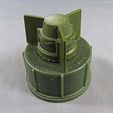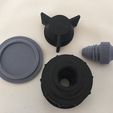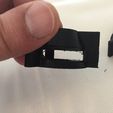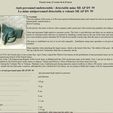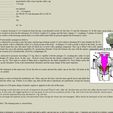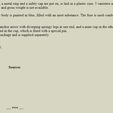Note: print safety cap @99%
Anti-personnel undetectable / detectable mine MI AP DV 59
La mine antipersonnel détectable à volonté MI AP DV 59
A warning!
This description of the mine is of the most general informational nature and cannot be used as an instruction, since some important points are intentionally omitted from it.
End of warning.
In the picture, the mine is shown with a separate safety guard and with a metal ring installed, providing a mine detector with a metal detector.
Mine anti-personnel high-explosive pressure action. The body is polyethylene and there are no metal parts in the mine design. Detection of mines by induction mine detectors is ensured by installing a metal ring on the top of the mine and using a metal detonator cap R54. If you use a non-metallic primer-detonator ID 56 and do not install a metal ring, then the mine is not detected by the mine detector.
The mine is established on soil or in soil only manually. Installation using mine spreaders is not provided. On the non-recoverability is not installed.
Mine explodes when attacking the target sensor, which is the head of the fuse. The defeat of the goal - the gap of about a quarter to a third of the leg with the feet. Sometimes fatal due to traumatic shock.
Mina was put into service in 1959. As of 2016, the French army is not a mine face, since France signed the Ottawa Convention on the prohibition of anti-personnel mines on July 23, 1998, and ratified it on March 1, 1999. However, it is studied in the Engineering School of the French Army.
The author in 2013 at the Training Center of the 15th Engineering Brigade of the Czech Army in Bekhin held this 2005 production mine in his hands. True, I can not say that it is made in France.
A large number of these mines were installed by the French army in the sixties in Algeria, Tunisia and Morocco. Most of them have not been removed so far.
Some of these mines were encountered during the Vietnam War in Vietnam, Thailand, Laos, Cambodia and during numerous armed conflicts in Africa. Obviously, some stocks of these mines exist in a number of countries in Africa and Southeast Asia, despite the fact that many countries, although they have ratified the Convention, are not going to fulfill and comply with its requirements.
Tactical and technical characteristics of anti-personnel mine MI AP DV 59
Type of mine- anti-personnel high explosive pressure
Body Material- polyethylene
Total weight- 130 gr.
Mass of explosives (tetryl and trotyl)- 70 gr.
Diameter- 60 mm
Mine height (at the top of the fuse)- 60 mm
Mine height (without fuse)- 3.2 mm
The diameter of the pressure sensor target- 2 mm
The force trigger pressure sensor target- 5-25 kg.
The time of bringing into combat- immediately after removing the safety cap
Time to lay mines (1 soldier)- 5-10 min.
Time of combat work- not limited
Temperature Range- -40 - +50 degrees
Fuse- AL PR ID 59 with detonator R54 or ID 56
Neutralization- Yes
Recoverability- Yes
Self-liquidation / Self-neutralization- no / no
Structurally mine is plastic housing (1) of cylindrical form having a top threaded socket for the fuse (2) and the detonator (3) In the main cavity body around the socket for the fuse located in between the detonator (4) of tetryl weight of 15 grams and the basic charge (5 ) weighing 55 grams of melted TNT. On the upper surface of the housing outside there is a removable metal disk (6) pressed against the housing by a fuse.
Fuse AL PR ID 59 structurally arranged as follows:
The body (1) with a thread for screwing it into the mine, and having a bottom nozzle (2) into which a detonator R54 and whether the ID 56 .
A head (3) of elastic plastic with a collapsible collar (4) is fixed on top of the body . A plunger (5) with a needle is fixed in the head. A cone-shaped cup (6) is fixed inside the case, the inner walls of which are covered with a grating compound. This cup is filled with a jelly igniter composition (7). Under the cup is the ignition amplifier (8). (potassium Chlorate). From the bottom, the case with the igniter composition and the flame amplifier located in it is hermetically closed by a diaphragm (9).
If the head (3) is subjected to pressure exceeding 5-25 kg, then it, together with the plunger (5), crushing the collar (4) and piercing the diaphragm (9) drops down. In this case , friction occurs between the igniter composition (7) and the grating composition of the cup (6). This leads to a flash of flame that is amplified by the flame amplifier (8). Force flame enters the nozzle and blows up the detonator. From it the intermediate detonator and the main charge of the mine explodes.
The installation of mines:
Remove the safety cap and unscrew the fuse from the mines. Put the detonator in the mine nest. Screw the fuse in a mine and put the safety cap on the fuse. Set mine in the hole or on the surface. Remove the safety cap from the fuse. Mine in combat
Neutralization or destruction of mines.
Mine clearance is done by installing a safety cap, after which the mine is removed from the installation site. Then, unscrew the fuse, turn the mine upside down and shake the detonator on the palm. After that, screw the fuse in place and install the safety cap. If there is no safety cap, then all the above operations are performed, except for actions with a safety cap.
The destruction of a mine is made at the site of detection with the help of a 200-gram charge of plastic explosive applied to the side of the mine.
From the author. A very strange and dangerous method of deactivating a mine that does not at all correspond to the usual French rules. After all, the fuse does not have any safety devices and it is impossible to bring it to the safety position before being removed from the mine. In this case, the triggering force is not too great. It can work at a pressure of only 5 kg. And if the mine has stood for several years, especially under adverse weather conditions, the elastic plastic will age, crack, and the response force may decrease to 1 kg. and less.
The most correct way is to be guided by Russian norms that do not envisage the disposal of any anti-personnel mines (except for those that are managed). Mine should be destroyed at the site of detection by an overhead explosive.
The color of the mine: Army green or sandy yellow. The training mine is colored blue.
Marking of mines: No information available.
Capping mine . Each mine in which the fuse without a detonator is screwed in, a metal ring and a safety cap are put on, is laid in a plastic case. 5 canisters are placed in a plastic container, which also contains a case with detonators. Information about the size of the capping and gross weight is not available.
For training personnel in dealing with a mine, there is its training option. The body is painted in blue, filled with an inert substance. The fuse is used combat, but with an inert detonator.
The mine can be used with a special device, which is a plastic rod, having an anchor arrow with diverging springy legs at one end, and a mine cup in the other end.
The device is driven into the ground in the right place, and then a mine is placed in the cup, which is fixed with a special pin.
Rod length from 15 to 25 centimeters. The device is not included in the mine package and is supplied separately.
This device is designed to protect the mine from displacement if:
* the mine is placed in water (at the bottom of the ford);
* the mine is installed on a slope of height, where abundant rainfall is frequent;
* The mine is set in moving sandy soils.
!Don't forget to check out my other Cool designs and Follow my Daily dose of KooKoo uploads, Enjoy ;)

/https://fbi.cults3d.com/uploaders/13409768/illustration-file/428d98a4-8297-4180-8ba1-de2aa0dfaad7/d13be3e0368dfad91e7e2d5d681b0a3a_display_large.jpg)






